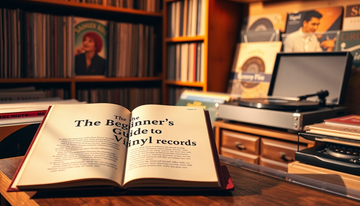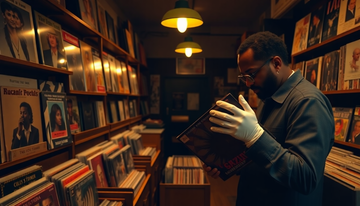In the digital age, where music is often consumed through small smartphone screens, the art of album cover design might seem like a relic of the past. However, for vinyl enthusiasts, the visual appeal of record sleeves remains an integral part of the listening experience. The resurgence of vinyl in recent years has breathed new life into this often-overlooked aspect of the music industry, reminding us that album covers are not just packaging, but a canvas for artistic expression.
The Evolution of Album Cover Art
The history of album cover art is as rich and diverse as the music it represents. In the early days of the recording industry, album covers were often simple and functional, serving primarily to display the artist's name and the album title. However, as the medium evolved, so too did the creative approaches to album design.
The 1960s and 1970s are often considered the golden age of album artwork, with iconic designs that have become as recognizable as the music they represent. From the psychedelic swirls of Pink Floyd's "The Dark Side of the Moon" to the minimalist elegance of The Beatles' "Abbey Road," these covers captured the spirit of the era and helped to define the visual identity of the artists.
As the decades passed, album cover design continued to evolve, with artists and designers pushing the boundaries of what was possible. The rise of digital technology has opened up new avenues for experimentation, allowing for more complex and dynamic designs that can be tailored to the specific needs of the music.
The Impact of Album Covers on Music Experience
Album covers are more than just packaging; they are an integral part of the music listening experience. The visual identity of an artist can be just as important as their sound, and a well-designed cover can help to create a sense of anticipation and excitement for the listener.
For collectors, the album cover is a crucial part of the vinyl experience. The larger format and higher-quality materials used in vinyl pressing allow for a more immersive visual experience, with intricate details and textures that can be appreciated in a way that is simply not possible with digital formats.
Moreover, album covers can serve as a means of enhancing the listener's engagement with the music. By providing a visual narrative or thematic context, the cover art can help to shape the way the listener interprets and experiences the album. This can be particularly powerful in the case of concept albums or thematic collections, where the visual and auditory elements work in tandem to create a cohesive artistic statement.
Design Elements in Vinyl Album Artwork
The art of album cover design is a complex and multifaceted discipline, drawing on a wide range of design elements to create a visually compelling and meaningful experience. From the choice of typography and font to the use of color and imagery, each decision made by the designer can have a profound impact on the overall aesthetic and emotional resonance of the album.
One of the most important design elements in vinyl album artwork is the use of typography. The font and layout of the artist's name, album title, and any accompanying text can convey a sense of mood, genre, or even the artist's personality. Designers often experiment with unconventional typefaces or custom lettering to create a unique and memorable visual identity.
Color theory also plays a crucial role in album cover design. The choice of color palette can evoke specific emotions or associations, and can be used to create a cohesive visual theme across the album's artwork. Designers may also incorporate the use of contrast, texture, and other visual elements to create a sense of depth and complexity.
Finally, the use of imagery and symbolism is a hallmark of great album cover design. From abstract and surreal compositions to photographic portraits and conceptual illustrations, the visual elements of the cover can serve to enhance the listener's understanding and appreciation of the music.
Notable Album Covers and Their Stories
Throughout the history of recorded music, there have been countless iconic album covers that have left an indelible mark on the industry. Some of the most notable examples include:
-
"Abbey Road" by The Beatles: The simple yet iconic image of the four band members crossing the street outside the Abbey Road Studios has become one of the most recognizable album covers of all time.
-
"Nevermind" by Nirvana: The striking image of a naked baby swimming after a dollar bill on a fishhook has become a symbol of the grunge era and the album's themes of consumerism and innocence.
-
"Sticky Fingers" by The Rolling Stones: The album cover, designed by Andy Warhol, features a real working zipper that opens to reveal a pair of jeans, creating a tactile and interactive experience for the listener.
-
"Rumours" by Fleetwood Mac: The striking black-and-white portrait of the band members, captured in a moment of tension and introspection, perfectly encapsulates the emotional turmoil that went into the creation of the album.
These are just a few examples of the countless album covers that have become cultural touchstones, serving as visual representations of the music they contain and the artists who created them.
The Resurgence of Vinyl and Its Effect on Cover Art
The recent resurgence of vinyl has had a profound impact on the world of album cover art. As listeners rediscover the tactile and immersive experience of vinyl, the importance of the visual elements of the format has become increasingly apparent.
The larger format of vinyl albums allows for a more expansive and detailed canvas for designers to work with, enabling them to create intricate and visually striking artwork that simply cannot be replicated on a CD or digital download. This has led to a renewed appreciation for the art of album cover design, with many artists and labels investing significant resources into creating truly exceptional and memorable covers.
Moreover, the revival of vinyl has also opened up new opportunities for creative expression and collaboration. Artists and designers are increasingly working together to create covers that not only complement the music but also serve as standalone works of art. This has led to a proliferation of limited-edition and special-edition vinyl releases, each with its own unique and collectible cover design.
Conclusion
In the end, the art of album cover design is not just about packaging; it is a vital component of the music listening experience. From the iconic covers of the past to the innovative designs of the present, the visual appeal of vinyl records continues to captivate and inspire music fans around the world.
As we move forward in the digital age, it is important to remember that the art of album cover design is not a relic of the past, but a living, breathing art form that continues to evolve and inspire. Whether you're a seasoned collector or just starting your vinyl journey, the visual experience of the album cover is an essential part of the magic of music.






